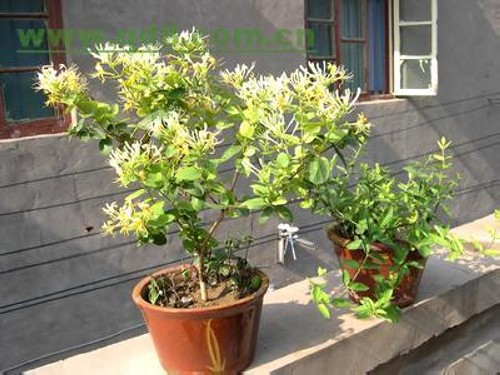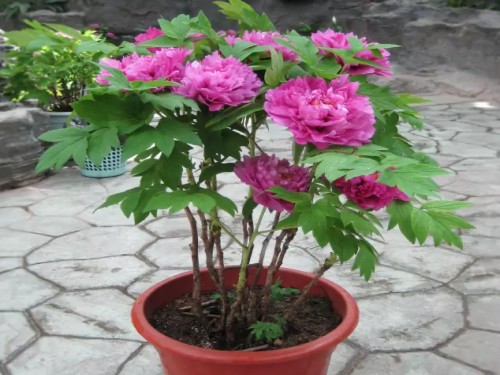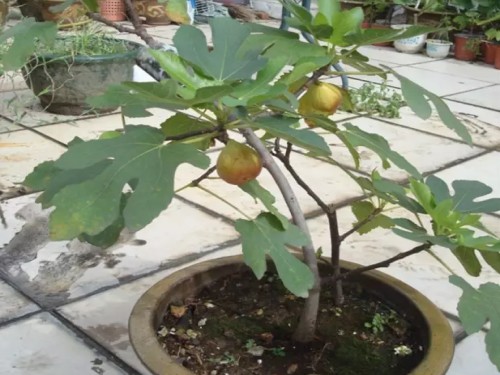Pot technology of honeysuckle: planting technique of potted honeysuckle
Honeysuckle is a temperate and subtropical tree species, which is sunny, shade-tolerant, cold-tolerant, drought-resistant and moisture-tolerant, and can adapt to acid and alkaline soil, but it likes loose and fertile neutral sandy loam. It is a good material for bonsai production because of its strong nature, developed root system, strong sprouting ability, light plant, graceful posture and elegant old pile.
Honeysuckle is not only a common medicine, but also a plant that can be used as an ornamental. Honeysuckle vines around, winter leaves slightly red, winter does not wither; yellow and white, blooming constantly, first white and then yellow, color and fragrance, flowers and leaves are both beautiful, spring and summer. Honeysuckle bonsai is also quite beautiful.

1. Soil
Honeysuckle is not strict on soil, barren mountain and Weir can be cultivated, sandy loam is better, pH 5.5-7 is suitable for honeysuckle growth.
2. Reproduction
Propagate with seeds and cuttings. Cuttings are widely used in producing areas because of their high survival rate and quick income.
3. Raising seedlings
In the middle and last ten days of April, choose a good basin, fill and compact, and immediately water through. In the case of drought, water should be watered every 3 days. After 15 days, it can take root and sprout and transplant in the following spring.
4. Upper basin
Honeysuckle is not demanding on soil, but it is best to use mountain mud or mainly mountain mud plus an appropriate amount of rotten leaf soil, coal ball ash and so on to prepare culture soil. The suitable time for potting is early spring.
5. Colonization
Select the basin, use soil fertilizer as base fertilizer, cover a layer of fine soil after planting, step on the soil and pour through the fixed root water. If it doesn't rain for a long time, it should be watered and moisturized to ensure that the transplant survives.
6. Transplanting
When the seedling age is one year, it can be transplanted from the Spring Equinox to Grain Rain, and the density is determined by the soil quality.
7. Fertilization
Ploughing is carried out once a year in early spring and early winter, with a depth of about 25 centimeters. Combined with mid-ploughing and weeding, fertilizer is generally applied twice a year, the first spring application of budding fertilizer, timely watering after fertilization; the second topdressing in early winter, if possible, after each flower harvest.
8. Pruning
The main purpose of the first-2 years after transplanting is to cultivate the trunk and cut off the upper branches of the trunk 15-20 cm above the ground before germination in early spring to make the trunk grow stout and sprout many new branches. In the second year, 4-5 sturdy branches were selected, and the rest were cut to grow about 15 cm, making them form sturdy, erect dwarf shrubby plants. In the early spring, when honeysuckle has not yet germinated, the withered, weak and poor upright branches will be cut off from the bottom to the top and from the inside to the outside.
9. Pest control
Diseases and insect pests of honeysuckle are less common. The main diseases are anthracnose and honeysuckle powdery mildew, and the pests are mainly aphids. During the prevention and control, it is strictly forbidden to use toxic pesticides in the budding stage of honeysuckle to prevent honeysuckle from losing its use value.
Time: 2019-05-24 Click:
- Prev

Planting techniques of potted peony
Peony is a symbol of wealth, auspiciousness, nobility and elegance. Cut peony is more popular than peony. Fresh cut peony is also a kind of variety with high value and grade, but not all peonies will adapt to cut flowers. it is also necessary to carefully select better peony varieties as cut peonies.
- Next

Planting techniques of potted figs
Figs are native to the Euro-Mediterranean coast and Central Asia. They were introduced to China in the Western Han Dynasty and have a long history of growing figs in the Tarim Basin. Figs do not bear fruit without flowers, its flowers are solitary, reddish, hidden in the receptacle, inconspicuous. When the fruit is ripe, the flower falls off, so it is called fig.
Related
- Fuxing push coffee new agricultural production and marketing class: lack of small-scale processing plants
- Jujube rice field leisure farm deep ploughing Yilan for five years to create a space for organic food and play
- Nongyu Farm-A trial of organic papaya for brave women with advanced technology
- Four points for attention in the prevention and control of diseases and insect pests of edible fungi
- How to add nutrient solution to Edible Fungi
- Is there any good way to control edible fungus mites?
- Open Inoculation Technology of Edible Fungi
- Is there any clever way to use fertilizer for edible fungus in winter?
- What agents are used to kill the pathogens of edible fungi in the mushroom shed?
- Rapid drying of Edible Fungi

